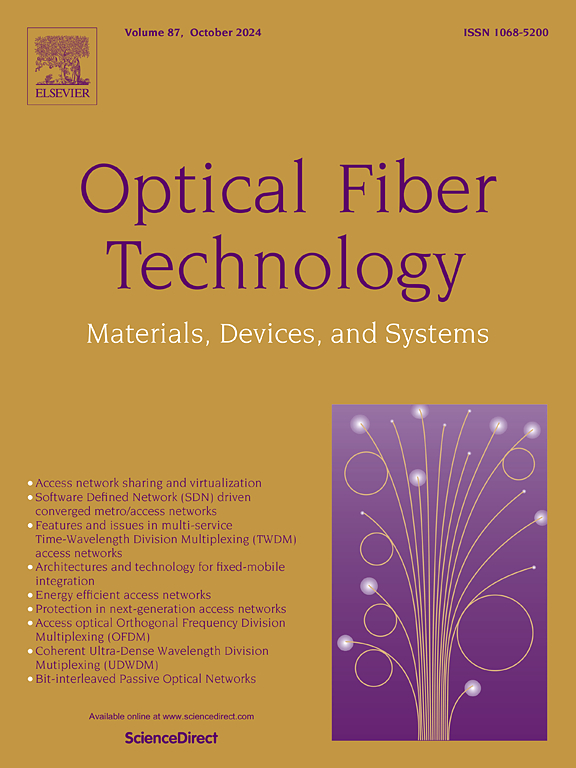Kerr beam self-cleaning under different initial modal excitation conditions in the anomalous dispersion regime of a graded-index multimode fiber
IF 2.6
3区 计算机科学
Q2 ENGINEERING, ELECTRICAL & ELECTRONIC
引用次数: 0
Abstract
We investigated the phenomenon of Kerr beam self-cleaning (KBSC) under a variety of initial modal excitation conditions in the anomalous dispersion region of a graded-index multimode fiber (GRIN-MMF) by solving the generalized multimode nonlinear Schrodinger equation (GMMNLSE). Our results clearly indicate that the phenomenon of beam self-cleaning is highly dependent on the initial modal excitation conditions, and the power threshold () required for beam self-cleanup varies depending on the initial modal energy distribution conditions considered. We also show that such beam self-cleanup does not occur for any arbitrary initial modal excitation, even at the highest values of input power launched. The temporal and spectral analysis reveals that a spatiotemporal soliton formed initially at a certain power value becomes unstable, thereby shedding dispersive waves and a number of multimode solitons through the fission process, and the nonlinear energy exchanges among the constituent modes lead to a self-cleaned multimode beam. Moreover, we also show that the use of the fiber of longer length permits us to substantially reduce the power threshold () required to observe beam self-cleaning. Our results realizing the Kerr beam self-cleaning effect with femtosecond pulses in the anomalous dispersion regime of a GRIN-MMF offer innovative and interesting perspectives for the potential extension of the concept of thermalization of classical nonlinear waves to the spatiotemporal domain and may pave the way for a better understanding and control of various novel nonlinear spatiotemporal phenomena in multimode platforms, in developing the next generation of tunable, broadband high-power lasers with nearly single-mode emission.
分级指数多模光纤反常色散机制中不同初始模态激发条件下的克尔光束自清洁功能
我们通过求解广义多模非线性薛定谔方程(GMMNLSE),研究了在分级索引多模光纤(GRIN-MMF)反常色散区各种初始模态激励条件下的克尔光束自清洁(KBSC)现象。我们的研究结果清楚地表明,光束自清洁现象高度依赖于初始模态激励条件,光束自清洁所需的功率阈值(Pth)随所考虑的初始模态能量分布条件而变化。我们还表明,对于任何任意初始模态激励,即使在发射的输入功率达到最高值时,也不会发生这种波束自清洁。时间和频谱分析表明,最初在一定功率值下形成的时空孤子会变得不稳定,从而通过裂变过程产生色散波和一些多模孤子,而组成模之间的非线性能量交换会导致多模光束的自清洁。此外,我们还发现,使用较长的光纤可以大大降低观测光束自清洁所需的功率阈值(Pth)。我们在 GRIN-MMF 的反常色散机制中用飞秒脉冲实现克尔光束自清洁效应的结果,为经典非线性波的热化概念向时空领域的潜在扩展提供了创新和有趣的前景,并可能为更好地理解和控制多模平台中的各种新型非线性时空现象铺平道路,从而开发出下一代近乎单模发射的可调谐宽带大功率激光器。
本文章由计算机程序翻译,如有差异,请以英文原文为准。
求助全文
约1分钟内获得全文
求助全文
来源期刊

Optical Fiber Technology
工程技术-电信学
CiteScore
4.80
自引率
11.10%
发文量
327
审稿时长
63 days
期刊介绍:
Innovations in optical fiber technology are revolutionizing world communications. Newly developed fiber amplifiers allow for direct transmission of high-speed signals over transcontinental distances without the need for electronic regeneration. Optical fibers find new applications in data processing. The impact of fiber materials, devices, and systems on communications in the coming decades will create an abundance of primary literature and the need for up-to-date reviews.
Optical Fiber Technology: Materials, Devices, and Systems is a new cutting-edge journal designed to fill a need in this rapidly evolving field for speedy publication of regular length papers. Both theoretical and experimental papers on fiber materials, devices, and system performance evaluation and measurements are eligible, with emphasis on practical applications.
 求助内容:
求助内容: 应助结果提醒方式:
应助结果提醒方式:


